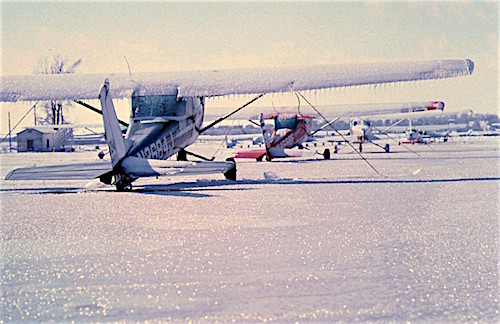Aircraft Icing
Learning Goal 3g. Explain how and where supercooled water forms,
and explain how ice on aircraft affects flight
Supercooled Water in the Atmosphere
Hard to believe, but liquid-water cloud and rain droplets can remain unfrozen at temperatures well below freezing in the atmosphere. In particular, these supercooled droplets can be liquid between temperatures of –40°C and 0°C. But supercooled liquid droplets freeze almost instantly when they touch something solid and cold such as an airplane, a snowflake, tree branches, power lines, runways, and road surfaces.
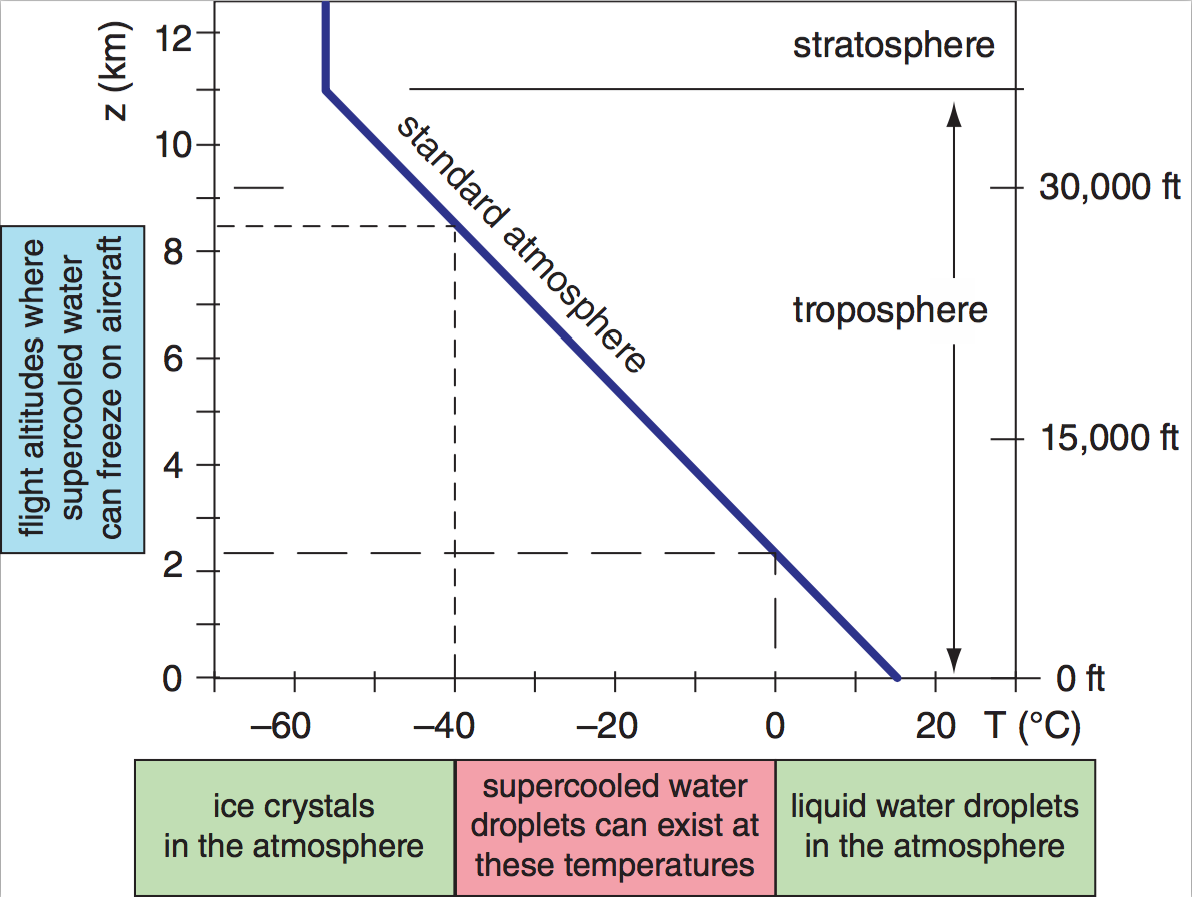
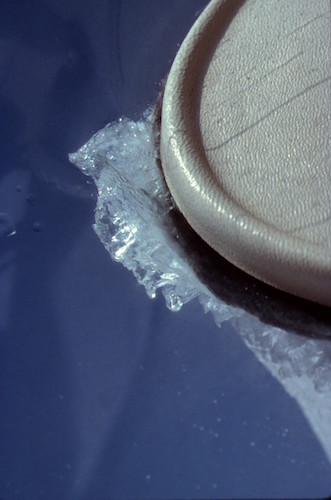
First diagram: Standard atmosphere temperature sounding. Higher in the graph corresponds to higher altitude above sea level.
Second image: Clear ice on leading edge of the wing, as viewed from inside the cockpit of a high-wing aircraft during flight.
At air temperatures between 0°C and -40°C, it is possible for the
cloud and precipitation to be all ice crystals, all liquid water, or a
mixture of liquid water and ice. But at these temperatures, any
liquid water is supercooled, and can freeze almost instantly when they
are hit by an airplane. Recall from Learning Goal 3a
that on average, the air temperature in the troposphere decreases with
altitude (see first diagram above). So as you climb away from the
earth's surface, you will reach a range of altitudes where the air
temperatures are between 0°C
and -40°C. Namely, that range of altitude is the danger zone for
ice formation on aircraft. But the danger exists only if the
aircraft is flying through liquid-water clouds or rain at those
altitudes. Namely, if you are flying in clear air at those
altitude, or if you are flying through clouds that are already 100% ice
crystals, then there is no hazard for ice to form on the aircraft
(except for a few exceptions described below).
As you climb to near the top of the troposphere, the temperature becomes colder than –40°C. At this altitude and above (i.e., in colder air), all liquid water is already frozen into ice crystals, so there is not normally an icing hazard at these altitudes. At any altitude, if the precipitation particles are already frozen (i.e., are snowflakes or ice crystals or sleet), then they are NOT normally a hazard to aircraft (see exceptions later), because the ice crystals simply blow around the aircraft and don't stick to it.
The actual atmospheric temperature sounding varies from day to day, location to location, and season to season. Thus, the actual sounding is always somewhat different from the idealized sounding shown above in the first figure. In summer, the icing hazard to aircraft might mainly be in the top half of thunderstorms and other deep convective clouds. In winter, freezing rain can reach all the way to the ground, forming ice on parked aircraft. In fall and spring, the supercooled water hazard is often associated with weather fronts such as warm fronts. Examples of frontal conditions that cause significant icing hazards are in Learning Goal 3h.
Ice on Aircraft - - Hazards
Why do we care about supercooled water? Because many bad things happen when a flying aircraft starts to accumulate ice on the aircraft:
- On wings, it disturbs the airflow, so the wing gets less lift (the upward force that keeps airplanes up).
- Anywhere on the aircraft, it adds weight (helping gravity to pull the aircraft down).
- On propellors, it decreases their thrust (the ability to pull the aircraft forward).
- Anywhere on the aircraft, it increases drag (tending to slow the aircraft due to friction).
- On the empennage (the tail of the airplane), it reduces the ability to keep the aircraft flying level.
- On the wind screen, it prevents you from seeing where you are going.
- On carbureted engines (not fuel injected; not turbines), ice forms in the carburator, partially or totally blocking flow of the fuel-air mixture into the cylinders of the engine (i.e., the engine loses power or dies).
- Ice
can form on engine air intake filters and manifolds, reducing the air
flow needed for the engines to properly burn their fuel. This literally chokes the engine.
- On some control surfaces (ailerons, elevator, rudder, flaps) it can prevent their movement so the pilot cannot control where the aircraft is flying.
- Ice can clog the pitot tube (which measures speed of the aircraft), causing erroneous speed readings in the cockpit.
- On some turbine (jet) engines, ice can form on the turbine blades, reducing thrust (see last subsection).
- On the space shuttle, ice that breaks off during launch can hit other parts of the shuttle that can damage the protective tiles on the wings and body, causing the shuttle to burn and explode during reentry.
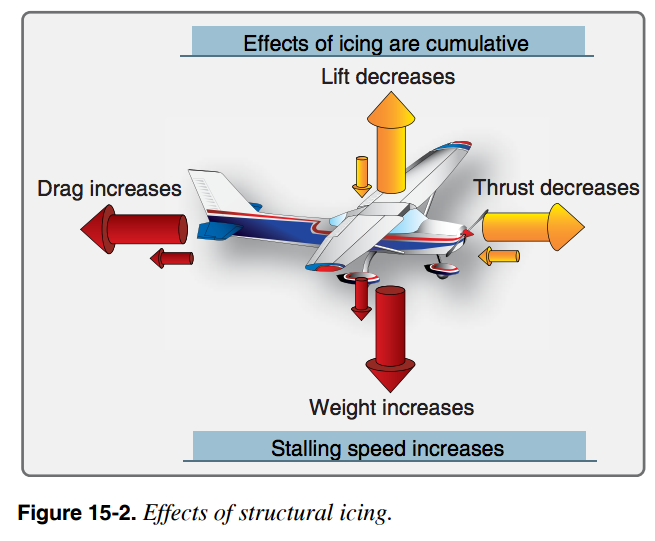
Courtesy of US FAA AMT Airframe Ch. 15. "Stall speed" is the slowest speed an aircraft can fly without falling out of the sky.
Some tips:
- If you are not flying in a cloud or through a rain shower, then ice will not form on the aircraft (see exception below).
- If you are at an altitude where the temperature is warmer than
freezing, then cloud and rain drops are usually not supercooled and do
not cause aircraft icing. They just give your plane a shower and wash off all the bugs.
- If you are at an altitude where the temperature is colder than –40°C, than ice will not form on the aircraft (see exception below).
- The rate of ice buildup depends on how much supercooled water is in the air. For non-precipitating clouds, the tiny cloud droplets cause a gradual accumulation of ice on the aircraft. For clouds with drizzle or light rain (in the cloud or falling below the cloud base), accumulation of ice is faster. If you are accidently flying through a thunderstorm at an altitude where heavy rain with large supercooled raindrops can occur, then ice buildup on the aircraft can be extremely rapid and dangerous (in addition to all the other thunderstorm hazards).
| Aside: Optional Training Videos about
Aircraft Icing I am putting these videos in an "Aside" box instead of an Experts box, because they might be interesting to non-pilots, even though the videos were designed for pilots.
|
Exceptions
Consider an aircraft that is very cold from flying at high altitudes. If the aircraft descends into warmer humid air, then frost can form on the aircraft even in non-cloudy air. This is similar to frost that forms on the inside of your house windows on a cold winter night. While the frost is not very heavy, it does increase drag and decrease lift, and if on the windscreen it can block your view.
Some of the newer high-bypass turbofan (jet) engines on modern fuel efficient airlines can develop ice on the turbines even when the aircraft is flying at high altitude where the temperature is colder than –40°C. Namely, there is no supercooled liquid water at these high altitudes — only ice crystals in the clouds. However, sometimes when these aircraft fly through high ice crystal clouds, the tiny ice crystals melt while flowing into the turbine and then refreeze on the turbine blades. This causes the engine to develop less power, or in extreme cases for the engine to stop running.
Types of Ice
For an aircraft that is flying, most of the ice forms on parts of the aircraft that the droplet-laden air hits straight on. These include leading edges of wings, horizontal and vertical stabilizer (in the tail), the nose (front) of the fusalege (aircraft body), propellor, tires, antennas, and other strutures that stick out into the air (pitot tube, thermometer, etc.).
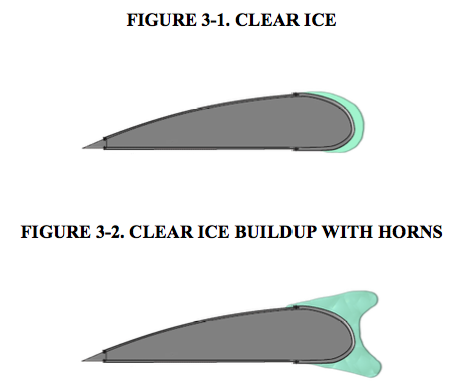 |
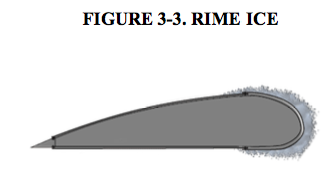 |
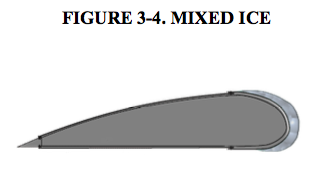 |
— Figures of cross sections of wings with ice, courtesy of US FAA AC 91-74B.
There are two main types of ice that form when supercooled water freezes: clear and rime (white).
- Clear ice: Larger raindrops take a second or more to freeze when they hit the aircraft, allowing some of the water to flow a short distance along the wing before freezing. Also, droplets in regions of 0 to –5°C air temperature freeze slowly. This "slow" freezing also allows any trapped air bubbles time to escape, causing this ice to be relatively clear (or dark) and very hard. It is difficult to remove this type of ice.
- Rime ice: forms when smaller cloud droplets freeze instantly upon hitting the leading edge of the wind and fuselage (body) of the aircraft. Also, droplets in regions of –15 to –20°C air temperature freeze faster. This traps air pockets between the frozen drops, which scatter the sunlight making the ice look white or milky. Also, this rime is relatively brittle and does not have much strength, so it can break off easier.
All images by Stull |
Clear ice |
Rime ice |
| On wing leading edge | 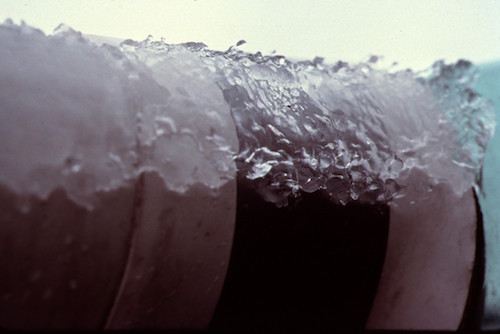 |
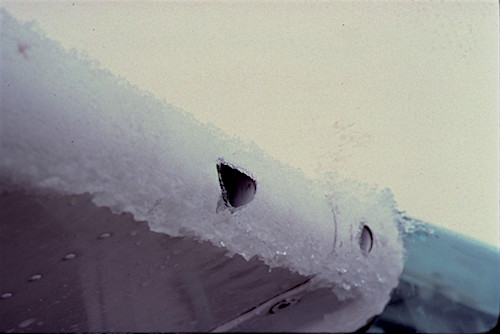 |
| On other items that stick out
from the aircraft. Left: thermometer Right: antenna |
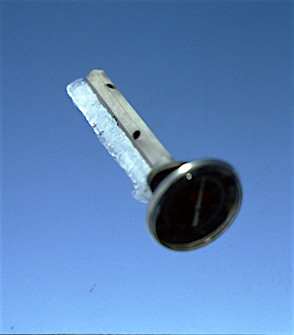 |
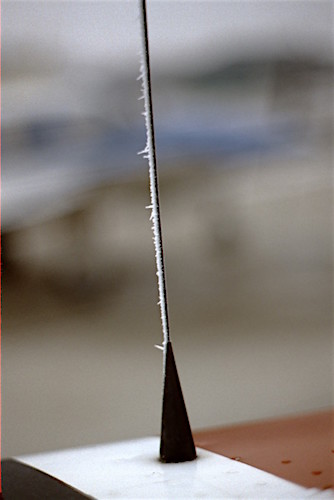 |
Also, layers or mixtures of clear and rime ice can form on an aircraft. Mixed ice is more frequent when the aircraft is flying in clouds where air temperature is –5 to –15°C.
Frost forms when water vapor (not liquid water) deposits on the aircraft and forms a "fuzz" of small ice crystals on the aircraft.
How Do PIlots Deal with Ice?
First, IFR pilots (see Learning Goal 1g) do their "homework", checking weather forecasts and pilot reports to pick a route (or to cancel or delay their flight) to avoid likely areas of ice, unless their aircraft is certified to handle ice. VFR pilots stay out of clouds anyway, so no problem there. But VFR pilots (who normally are allowed to fly through rain showers if the visibility is good enough) should avoid flying through rain showers if the air temperature is below freezing at their flight altitude.
Some of the more expensive general aviation aircraft and almost all commercial aircraft and airlines have de-icing equipment or anti-icing equipment on the aircraft. De-icing removes ice that has formed. Anti-icing prevents the ice from forming.
- Some jet aircraft duct some of the hot jet exhaust through the wing leading edges and other critical areas of the aircraft, to keep them too warm for ice to form.
- Other aircraft have electric heaters embedded in the wings or glued to the leading edge, but these heaters draw so much electricity that they are not used on smaller aircraft.
- Some aircraft have pneumatic boots glued to the leading edge of the wing (where ice usually has the greatest accumulation), which can be inflated and deflated with air to crack off any ice that has formed. You can recognize these as the black covering on the leading edge of the wing.
- Some aircraft carry a special antifreeze or other chemical that can be pumped onto the propellors or windscreen to disolve the ice.
- Almost all carburated aircraft have a control called "Carburator Heat" that can be activated by the pilot to draw warm air from near the hot engine into the carburator. This reduces engine power slightly (because hot air is less dense and has fewer oxygen molecules for the engine to use), but melts or prevents carburetor ice which would otherwise cause the engine to stop.
| Wing heated by jet exhaust | 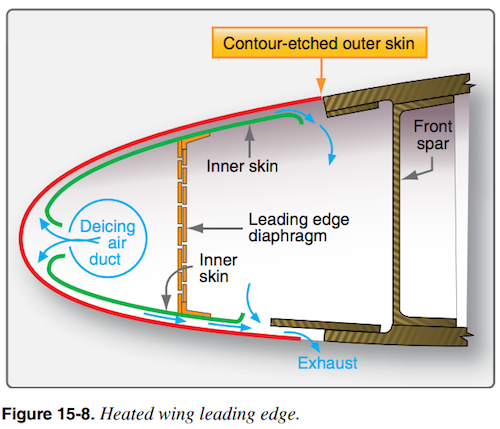 |
 |
| Pneumatic de-icing boot |  |
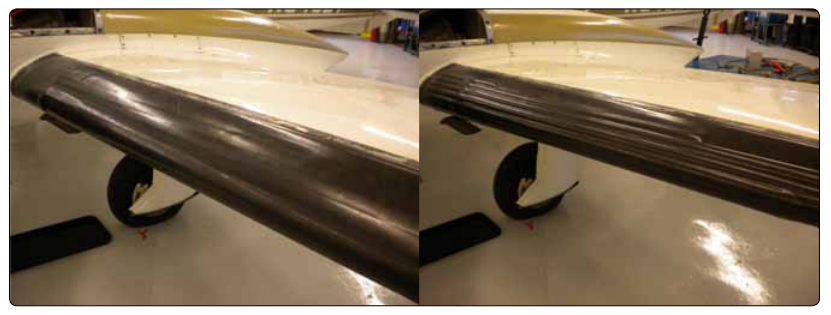 |
| Chemical spray (the spray tubes
look like windshield wipers in this photo) |
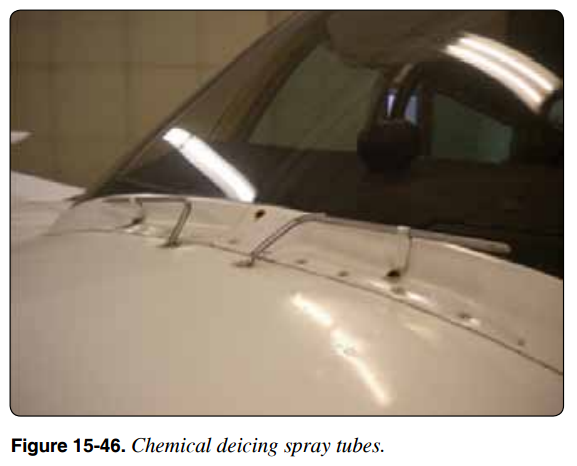 |
All images courtesy of the US
FAA. AMT Airframe Handbook, Chapter 15 (see extra info below). |
For aircraft that don't have de-icing equipment and accidently find themselves in a cloud with ice accumulating on the aircraft, three actions are recommended (assuming the pilot asks and receives the appropriate clearance from air traffic control):
- Fly out of the cloud (laterally or vertically).
Namely, make a U-turn to fly out of the cloud, or climb or descend to
clear air above or below the cloud.
- Climb to altitudes where there might be warmer air in the cloud (no guarantees that warmer air exists at higher altitudes)
- Descend to altitudes where the air is warmer in the cloud or rain (doesn't work in winter when the cold air reaches the ground)
But even after you fly out of the cloud, your aircraft still has a load of ice on it. This will evaporate (sublimate*) very slowly in clear air, even if you are still flying in air below freezing. However, it could take an hour or more of flight to evaporate all the ice. Usually it is easier to change altitude to where the air is warmer so the ice melts quickly.
Note: * sublimation = direct evaporation without melting first.
Pilot Reports (PIREPS) of Ice
If a pilot experiences ice accumulation on her/his aircraft, the pilot can help other pilots arriving later by radioing a report of the weather conditions (called a PIREP) to air traffic controllers or flight service station personnel on the ground. Both the US and Canada use the same terminology for aircraft icing intensity. Here are the quotes from the US AIM:
- Trace - Ice becomes perceptible. Rate of accumulation slightly greater than sublimation*. De-icing/anti-icing equipment is not utilized unless encountered for an extended period of time (over 1 hour).
- Light - The rate of accumulation may create a problem if flight is prolonged in this environment (over 1 hour). Occasional use of deicing/anti-icing equipment removes/prevents accumulation. It does not present a problem if the deicing/anti-icing equipment is used.
- Moderate - The rate of accumulation is such that even short encounters become potentially hazardous. Use of deicing/anti-icing equipment or flight diversion (change your route or destination) is necessary.
- Severe - The rate of accumulation is such that deicing/anti-icing equipment fails to reduce or control the hazard. Immediate flight diversion is necessary.
Ice on the Ground
Sadly, even when the aircraft is parked on the ground, freezing rain can cause ice to form on the aircraft. This ice forms on all the top surfaces of the aircraft, not on the leading edge. It adds tremendous weight to the aircraft, and must be removed before flight. Ways to remove this include spraying with a de-icer (hot antifreeze), move the aircraft in to a warm hangar, or wait until a sunny day to melt the ice.
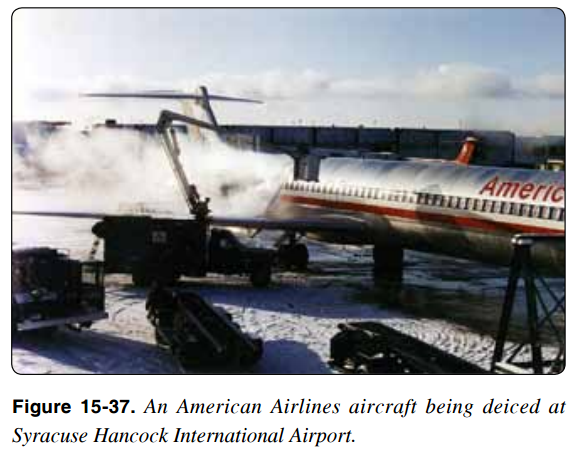
First photo by Stull. Second photo courtesy of US FAA AMT Airframe handbook, Chapter 15.
However, these ice storms also coat the runways, taxiways, and parking ramps/aprons with a layer of ice, making it difficult or impossible to taxi (drive the aircraft on the ground) and takeoff or land. Also, the roads to the airport might be ice covered and slippery, so you might not be able to drive to the airport in your car.
Often on clear nights in air that is humid, frost can form on the top surfaces of the aircraft wings, fuselage, and empenage (tail). This can be avoided by putting a cover over the aircraft, or moving the aircraft into a hangar or under a tree. Once the frost has formed, the pilot can wait a couple hours for the sun to melt and evaporate the frost, or can try to brush off and rub smooth the frost. Also, the de-icing fluid (antifreeze) can be sponged, mopped, or sprayed onto the aircraft.
Ice Crystal Icing (ICI)
Normally, ice forms on aircraft when the aircraft flys through LIQUID
water that is below freezing. Also normally, if an aircraft flys
through cloud particles that are already frozen (SOLID snowflakes or
ice crystals), these just blow around the aircraft and don't stick, so they are not a hazard.Often the intake nacelle of jet engines is intentionally heated by jet exhaust to prevent LIQUID supercooled water from freezing on it. This works great to prevent the normal formation of ice, but there is an exception.
When an aircraft flys through an ice-crystal cloud, if conditions are right then the ice instantly melts when it enters the heated nacelle at the jet-engine inlet, but then re-freezes on turbine blades in the first part of the engine. Ice can build up on those turbine blades. This degrades performance of the engine, and can damage the engine if chunks of ice break off and shatter the turbine blades further back in the engine. This phenomenon is called Ice Crystal Icing (ICI).
Although this is a very rare event, it has caused over 150 incidents of power-loss or engine damage to jet aircraft over the past 20 years. Most reports were when jet aircraft were flying at high altitude through the ice-crystal tops of tropical thunderstorms. This is NOT a hazard that most general aviation (light airplane) pilots would encounter, but it could affect passengers on commercial flights. Luckily, in most cases when a jet engine is damaged due to ICI, the pilot can continue flying the aircraft on the other engines to reach the nearest airport for an emergency (safe) landing.
Key words: supercooled droplets, clear ice, rime
ice, mixed ice, frost, de-icing, anti-icing, ice-crystal icing.
Extra info for experts; not needed for this course.
- US FAA AC 91-74B - Pilot Guide: Flight in Icing Conditions. (2015). Excellent and up to date.
- Transport Canada AIM, section 10 "AIR": Airmanship, paragraphs 2.12.3 on Airframe Icing. Also section 4 "MET": Meteorology, paragraphs 2.4 and 4.12 on Airframe Icing and Icing Forecasts.
- US FAA AC 00-6B - Aviation Weather (2016), Chapter 18. Icing. Also Section 19.6.5 on Icing in Thunderstorms.
- FAA-AIM, (13 Sep 2018) section 7-1-21 & 22, Airframe Icing.
- US FAA FAR 91.527 Operating in icing conditions.
- US FAA AMT Airframe handbook-Volume 2. (2018) FAA-H-8083-31A. AMA Chapter 15: Ice and Rain Protection.
- Journal article on Ice Crystal Icing (ICI): Haggerty et al, January 2019: Detecting clouds associated with jet engine ice crystal icing. Bulletin of the American Meteorological Society, 100 (1), 31-40. https://journals.ametsoc.org/doi/full/10.1175/BAMS-D-17-0252.1
Additional books that can be purchased:
- Peter F. Lester, 2013: Aviation Weather, 4th Ed., Jeppesen/Boeing. Chapter 13 Icing. ISBN 978-0-88487-594-9. Excellent.
- Royal Canadian Air Force Weather Manual (2012). B-GA-007-001/PT-D01. Chapter 9: Aircraft Icing. ISBN: 978-0-660-20260-0. and Workbook .
- Doug Morris, 2017: Canadian Aviation Weather, 2nd Ed. Chapter 12: Airframe Icing.
Videos for experts:
- NASA Glenn Research Center video about tailplane ice. https://www.youtube.com/watch?v=gSHjs2dhs8A
- Also, see the Aside box above, which has links to two training videos.
All the photos were taken by Roland Stull, and the drawings were made by Roland Stull, and all are copyright by him and used with his permission, except as listed near the figures.
